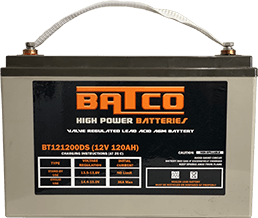
Deep Cycle Marine Battery vs. Cranking Battery
If you're out on the water often, you already know how critical it is to have the correct marine battery for your vessel. But, with so many various types of marine batteries available, how can you know which one is suitable for you?
Choosing the best marine batteries entails more than simply selecting a reputable brand that you can rely on. Even the best battery is only as good as how it is used and cared for. Knowing the distinctions between the two most prevalent types of marine batteries, cranking batteries and deep cycle marine batteries, is the first step.
WHAT IS A MARINE CRANKING BATTERY
A marine cranking battery is an excellent alternative if you require a boat starting battery. When the ignition switch is turned on, a cranking battery sends electricity to the engine, allowing a maritime vessel to start. As a result, these batteries are sometimes referred to as starter batteries. Short and powerful bursts of energy must be sent from the battery to start a motor.
FEATURES OF A CRANKING BATTERY DESIGN
The larger the plate surface area inside the battery, the easier it is for it to deliver the required power. Cranking batteries have a lot of thin plates because they improve surface area and make starting a marine vehicle as smooth and reliable as possible.
A starting battery's characteristics that make it perfect for cranking an engine also make it less than ideal for continuous discharge or "cyclic" use. As a result, deep cycle marine batteries are a must-have for boat users.

WHAT IS A MARINE DEEP CYCLE BATTERY?
After a boat's engine has started, it no longer requires the same rapid and intense bursts of energy that a starter battery provides. Instead, the boat requires constant, dependable electricity for trolling, as well as the operation of electronics such as sonar, GPS, and radios.
FEATURES OF A DEEP CYCLE MARINE BATTERY
Deep cycle marine batteries can help with this. There are significant architectural variations between a deep cycle marine battery and a trolling battery. The battery plate is one significant difference: it has fewer, thicker plates, allowing the battery to offer continuous power production for longer periods of time. Deep cycle batteries, unlike cranking batteries, can be completely discharged and recharged multiple times. Because their stronger plate design can sustain high temperatures during intense currents, deep cycle marine batteries are far less likely to overheat.
WHY CAN’T THE SAME BATTERY BE USED FOR CRANKING AND TROLLING?
It's tempting for any boater to want to keep their vessel's accessories and upgrades to a minimum. However, in the long term, that method will cost you more money and time. Combining the performance of a cranking battery and a deep cycle battery into one battery is quite difficult. They're both designed to do very different tasks.
When a cranking battery is used continuously (for example, trolling), it might overheat and lose capacity. Similarly, a deep cycle battery will not always operate when called upon to produce the bursts of energy required to start an engine.
To put it another way, when you use two distinct marine batteries, you'll usually obtain the best performance and the lowest operating expenses.
CRANKING BATTERY VS. DEEP CYCLE MARINE BATTERY: AN OVERVIEW
A cranking battery allows a boat to start and get out on the water quickly.
In any scenario, a deep-cycle (trolling) battery keeps it running and runs electronics.

DUAL PURPOSE MARINE BATTERIES ARE A THIRD OPTION (FOR SOME PEOPLE)
There are exceptions to every rule, as there are to many others. Furthermore, certain dual-purpose batteries are capable of both cranking and trolling. These dual-purpose batteries, on the other hand, aren't necessarily the best choice for every boat. Although, like many "2-in-1" solutions, they mean one less battery to buy and maintain, they may not necessarily allow a vessel to operate at the same level as two batteries.
Deep cycle batteries, for example, are designed to tolerate multiple discharges and recharges, whereas cranking batteries are not. As a result, a dual-purpose battery falls somewhere in the middle. Many are unable to withstand entire discharges (discharge beyond 50 percent of usable capacity).
Which chemistry is best for you now that you know what battery options you'll need?
Let us help you narrow down your options, contact our battery specialist now!